Kayaks come in all shapes and forms, and there are plenty of models designed with the beginner in mind.
With recreational kayaks to fishing vessels out there, knowing just where you’re heading with your kayaking future can help take out some of the confusion.
Are you looking at just taking your kayak out for a few trips during the summer?
Is the ocean calling you? Are you hoping to use your kayak for fishing?
Do you want to kayak with a friend or even make it a family venture?
No matter the trip you’re going to take, just because you’re looking into a beginner’s kayak doesn’t mean you have to compromise.
Overall, a good beginner’s kayak will give you smooth paddling and stability in the water.
Looking into a more durable model will pay off, too, so you don’t have to stress out about any bumps you may encounter while getting the hang of the sport, either.
You’ll also see the distinction mentioned between sit in and sit on kayaks.
Both are valid options but sit on models are more accessible to board, while sit in kayaks are more suited for colder waters and give a bit more maneuverability.
Best Kayaks for Beginners – Comparison Chart
| MODEL | SEATING | STYLE | ACTIVITY | SIZE | WEIGHT | CAPACITY | BUY AT |
|---|---|---|---|---|---|---|---|
| Elie Sound 100XE Kayak | Sit-In | Solo | Recreational | 10′ x 28″ | 41 lbs. | 300 lbs. | REI |
| Perception Expression 11.5 Kayak | Sit-In | Solo | Touring | 11′ x 7″ | 44 lbs. | 250 lbs | REI, Eastern Mountain Sports |
| Wilderness Systems Tarpon 100 Kayak | Sit-On | Solo | Recreational | 10′ x 30″ | 41 lbs. | 325 lbs. | Amazon, REI |
| Lifetime Emotion Glide Sport Kayak | Sit-In | Solo | Recreational | 9’8″ x 29″ | 37 lbs. | 275 lbs | Amazon |
| Intex Challenger K-1 Inflatable Kayak | Sit-In | Solo | Recreational | 9′ x 30″ | 23.9 lbs. | 220 lbs. | Amazon, Walmart |
| Lifetime Manta 10 Foot, Two Person Tandem Sit-on Kayak with Padded Backrests | Sit-On | Tandem | Recreational | 10′ x 36″ | 60 lbs. | 500 lbs. | Amazon, Walmart |
| Lifetime Wave Youth – Kids Kayak | Sit-On | Solo | Recreational | 6′ x 24″ | 18 lbs. | 130 lbs. | Amazon, Walmart |
| Old Town Canoes and Kayaks Heron Kids Junior Kayak | Sit-On | Solo | Recreational | 7.5′ x 25″ | 26 lbs. | 125 lbs. | Amazon |
| Ocean Malibu Two Tandem Sit-On Top Kayak | Sit-On | Tandem | Recreational | 12′ x 34″ | 57 lbs. | 375-435 lbs. | Amazon, Cabela’s |
| Perception Pescador Pro 12 | Sit-On | Solo | Fishing | 12′ x 32.5″ | 64 lbs. | 375 lbs. | REI, Amazon |
| Sun Dolphin Aruba 10 | Sit-In | Solo | Recreational | 10′ x 30″ | 40 lbs. | 250 lbs. | Amazon, Walmart |
How to Choose the Best Kayak
Since picking out a kayak can be a significant investment, it’s essential to make the right decision.
There are as many varieties of kayaks as there are uses: recreational kayaks are best suited for short trips and are easy to maneuver, touring kayaks are a better fit for longer trips, and sea touring kayaks can cover the most distance and offer the most storage.
You can even find inflatable, folding, fishing, and tandem kayaks.
Overall, recreational and touring kayaks are the simplest to paddle, making them great for beginners.
But even inside these categories, there are more specific factors you can consider when making your purpose.
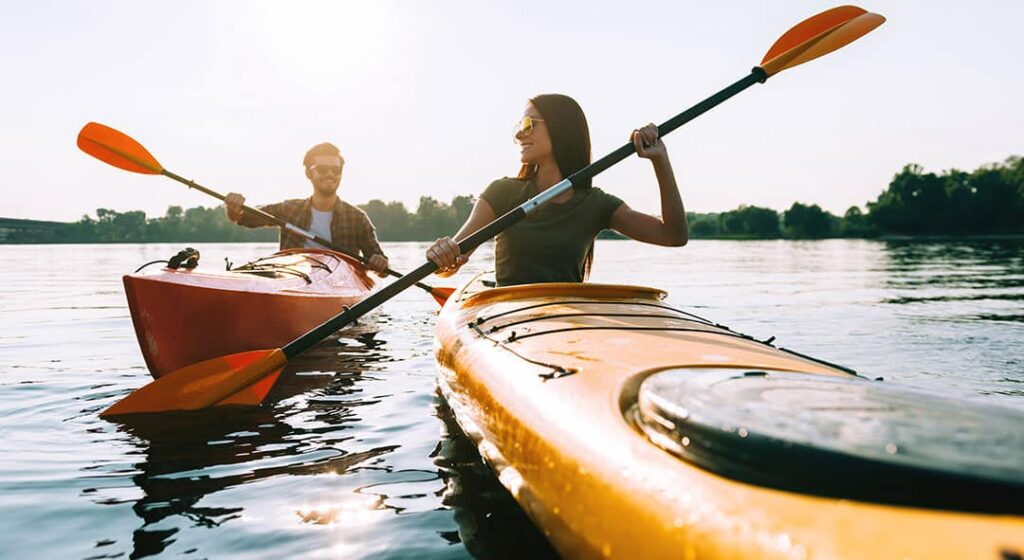
Sit-On vs. Sit-In
Beyond the purpose of a kayak, one of the distinctions you’ll see in types is whether the boat is sit-on or sit-in.
Telling them apart is as simple as it sounds.
With a sit on top kayak, there’s no cockpit. These boats are easy to board and disembark and are great for recreational use.
They’re also suited for warmer weather and waters since there’s no guard from water splash, but they drain themselves.
Overall, sit on tops are heavier and have less storage space.
They are beginner friendly, though, making a good purchase if you’re looking to kayak for fun.
Buying a more traditional sit-in model might be a good investment if you’re thinking about taking bigger trips with your kayak, though.
The cockpit provides more coverage from the water, meaning you can kayak in colder conditions, and sitting inside the boat gives you more maneuverability options.
There’s also increased storage, making them suitable for long-distance trips, though you will have to learn the proper way to exit if your boat capsizes.
Material
The most significant effect the material has on your kayaking experience is in the weight of the boat.
Heavier kayaks can be more difficult to carry and load, trickier to get up to speed, and often have less weight capacity.
More lightweight materials are less durable and come with a higher cost, so finding the right balance between your needs and budget is critical.
ABS plastic, polyethylene plastic, composite materials, and even wood are all common kayak materials.
Composites are lightweight but less durable, the plastics tend to have higher durability in exchange for weight and some weakness to UV, and wooden kayaks require some construction know-how or high building costs.
Inflatable kayaks have simple at home storage in mind, but a puncture can prove fatal, so they’re best suited for casual use.
Weight Capacity
The weight capacity accounts for the total weight of the boat, you as the paddler, and any additional gear you may be bringing with you.
Depending on just how far you want to paddle, a higher weight capacity will allow you to pack more inside your kayak.
Going over the weight capacity can lower the boat in the water and make it harder to paddle.
Size
Length and width affect how easy it is to make your boat go fast and straight.
A longer, narrower kayak will be easier to steer.
Shorter, wider kayaks are often more stable on the water and can make turns easier.
They are often less expensive, too, making a good choice for a starter kayak.
The bigger the dimensions your kayak has, the more storage space you’re likely to have.
If you’re looking to go fishing or on longer trips, you might want to sacrifice some speed for better storage options.
Hull Type
The hull plays a significant role in stability and performance.
In general, the narrower a hull is, and the smoother the edges are, the less resistance it’ll give to the water, and the faster it’ll go. The flatter the hull is, the more stability it’ll provide.
Before getting too far into the other details, it’s important to understand the different types of stability for kayaks.
Primary stability refers to how stable the kayak is to start—while boarding and while not in motion. Secondary stability refers to how stable the kayak is while you paddle.
Chine is a big part of the hull and refers to how the sides and bottom of the boat meet.
“Harder” chine means sharper angles, “softer” chine means smoother edges, and most kayaks are considered “multi-chine” and fall in the middle.
With a softer chine, your kayak will have secondary stability.
Flat hulls are stable and are great on flat water surfaces, a rounded hull will provide higher speeds, and V-shaped hulls cut through the water, making for better secondary stability but lower primary stability.
For beginners, flat hulls are most recommended to help with keeping balance while boarding, though you’ll also want to have a soft enough chine to make keeping upright while paddling easier.
Top 9 Rated: Best Beginner Kayaks Reviewed
We know you’re here to check out our reviews, so let’s jump right in!
Ocean Malibu Two Tandem Kayak – Editor’s Overall Choice – Best Beginner’s Tandem Kayak
As a tandem kayak, the Ocean Malibu Two can support two riders, but it also works great with just one paddler.
There’s plenty of room in both seats, and there’s even a third, smaller seat that can fit children or even dogs.
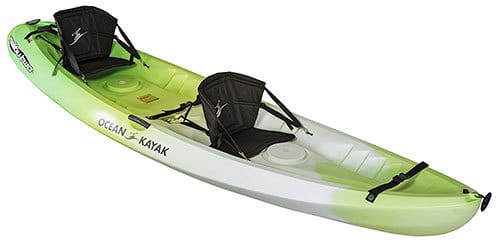
As a sit-on model, it’s also stable and responsive, making it suited for when both paddlers are building their skills.
Once you’ve gotten the hang of kayaking, though, it can make it through all water conditions, including ocean waters.
Beyond providing a good beginner’s base, this kayak can cover whatever waterfronts you may find yourself wanting to explore.
The durability is high-quality, too.
Beyond surviving beginner’s bumps, the Malibu Two can stay in great working shape for many years.
Being a sit on model, the Malibu won’t do much good in colder kayaking conditions.
Even with its versatility in water conditions, it’s not very fast.
Pros:
- Long lifespan
- Works with both solo and tandem riders
- Comfortable seating
- Suited for all water conditions
Cons:
- Limited storage space
- Weighs more than the average solo kayak
With great versatility for both single and tandem paddlers, this kayak is versatile for different users and whatever water conditions you’re aiming to sail.
It will survive long past beginner’s mishaps and through the years, making it a substantial investment across the board.
That’s why we think this is one of the best sit on top kayak for beginners who want a tandem model.
Lifetime Wave Youth Kayak – Editor’s Choice for Best Kids Kayak
While tandem boats often have smaller seats for young children, there’s also the option of giving them their kayak to use.
The Lifetime Wave Youth Kayak is a reliable choice for letting your kid take a shot at kayaking.
The wide stance helps with stability, and the overall build has developing motor skills in mind.

There’s no age limit—so long as the rider sits under the 130-pound weight limit, your child can use it for several years.
The multiple footrest positions can accommodate different heights, too, so it’s versatile.
Self-bailing scupper holes help drain water and prevent cockpit flooding.
This kayak also has a swim-up deck on the back, making it easier for kids to board.
Constructed of polyethylene plastic, this kayak is durable, and is even UV resistant, unlike some others, which means you don’t’ have to worry about sun damage during storage.
It also comes with a paddle and is available in multiple colors.
The most prominent downfall is that the kayak doesn’t keep dry very well, as is typical of sit on kayaks.
It also doesn’t have a cupholder, which might be something your kids could be picky about.
Pros:
- Comes with paddle
- Lighter weight
- Swim-up step for easy boarding and reboarding
- UV protection
- Reverse chine for enhanced stability
- Multiple color choices
Cons:
- No cupholder
Since it has enough space to cover a variety of heights, the Lifetime Youth Wave gives an excellent option for starting kayaking young and carrying on through the years.
The high durability against bumps and UV is notable, too, and the scupper holes plus its solid stability all earn points in its favor.
Sun Dolphin Aruba 10 Kayak – Editor’s Budget Choice – Cheap Beginner’s Kayak
The Sun Dolphin Aruba 10 is hard to beat as an inexpensive, recreational kayak.
Best suited for quiet lakes and rivers, it provides a great combination of balance and tracking for beginner’s practice.
With a flat bottom and broader body, turning is simple, and secondary stability holds up.
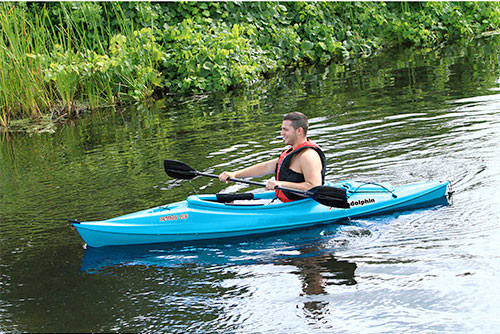
The high-density polyethylene plastic makes it a durable kayak. There’s a lot less worry about getting damage from practice mistakes with its sturdiness.
It’s easy to transport, too, at 40 pounds.
Its size can also fit into SUVs and trucks, sparing the trouble of having to purchase a transport rack.
The storage space, water bottle holder, and paddle holders provide extra convenience while on the water.
While great for calmer water conditions, the Sun Dolphin Aruba won’t hold up in rougher water conditions.
For the beginner kayaker that envisions a lot of turbulent waters in their future, it’s better to invest in a more versatile model.
Pros:
- Great value
- Comfortable seating area
- Lightweight
Cons:
- Not suited for a variety of water conditions
- Doesn’t come with seat cushion
When you’re looking to test the waters on a budget, the Sun Dolphin Aruba 10 provides an inexpensive but durable experience.
Easy transport, paddling, and storage options all give enough to get a taste of kayaking without breaking the bank.
Perception Pescador Pro 12 – Editor’s Choice for Best Fishing Kayak for Beginners
The Perception Pescador Pro 12 is a beginner sit-in kayak for those who know they want to use their boat for fishing.
It has two different mounts to hold fishing rods and plenty of waterproofed storage space for any gear.
With a polyethylene plastic hull, it’s also suitable for both salt and freshwater environments.
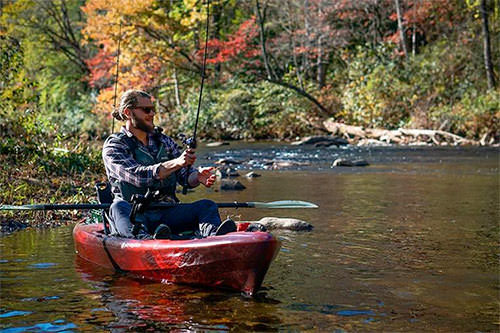
It has steady primary and secondary stability, making it easy to board. It also does a great job of keeping stable even in choppy waters, so there shouldn’t be many problems trying out kayaking in any environment, including whitewater or sea conditions.
It’s easy to paddle in a straight line and can cover long distances well.
Comfort isn’t shirked, either.
There’s plenty of leg room for even kayakers over six feet, and the seat is supportive and adjustable.
The biggest problem with the Pescador Pro is the weight.
While the high weight helps the stability of the boat, it can be hard to transport on your own.
Pros:
- High quality for the price
- Suited for a great variety of environments and conditions
- Great stability
Cons:
- Heavier weight makes for difficult transport
- Some rods don’t fit rod holders
As a beginner’s fishing kayak, the Perception Pescador Pro has a great variety of features for the price point.
When you’re looking to settle down on the water over traveling long distances, this kayak will give you high stability and storage options for a day of fishing.
Overall, we think that this is the best beginner kayak for fishing and it should last you well beyond your beginner years.
Emotion Glide Sport Kayak
The Emotion Glide Sport is a good starting kayak with some great comfort options.
Adjustable foot braces can accommodate taller paddlers, and the dual-density foam seat, comfort thigh pads, and backrest give a comfortable experience while paddling.
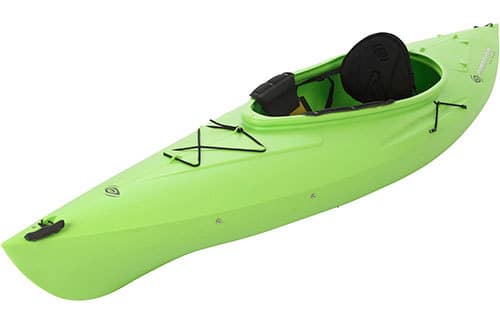
The smaller size gives this kayak some excellent maneuverability, and overall provides stable balance while maintaining speed, which some beginner kayaks lack.
The initial stability is high, too, making it easy to board.
Hand grips and the lighter weight combine for easy transport.
While it doesn’t come with a paddle, the Emotion Glide Sport does come with a paddle keeper if you need to set your paddle aside or use both hands.
There’s enough room in the cockpit to have some additional gear along with you, but this kayak doesn’t give any designated storage space, so it may not be suited if you’re planning on packing extras.
There are also some tracking issues, so you may have a hard time paddling in a straight line, especially in heavy wind conditions.
Pros:
- Easy transport
- Great comfort adjustability
- Better speed than other beginner kayaks
Cons:
- No dedicated storage spaces
- Some tracking issues
If you’re aiming for a flat-water kayaking experience, the Emotion Glide sport will serve you well. For short trips without much need for storage, this kayak will give you good practice with a maneuverable vessel.
Intex Challenger K-1 – Editor’s Choice Best Cheap Inflatable Kayak for Beginners
While storage space at home can be a big concern when looking into a kayak, inflatable models like the Intex Challenger K-1 can take away that stress.
It’s lighter weight and comes with a carrying bag, making transport and storage a breeze.
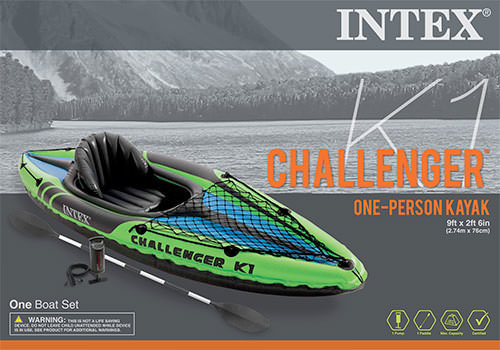
It comes with both a pump and oars at an already low price point. It’s a great kayak to test out the waters on if you’re not sure you’ll want to keep up kayaking after trying it out a few times.
The heavy-duty puncture resistant vinyl is built to be durable and can take a few rough bumps without damage.
Two separate air chambers prevent a total sink if you do gain a puncture.
The size and weight make it a good fit for all age ranges, from kids to older adults.
Being an inflatable kayak, you are sacrificing a lot of potential durability.
The Intex Challenger K-1 can take some hits, but it’s best to save this kayak for more relaxed waters and casual rides. It can have some trouble building speed, too.
Pros:
- Cheap
- Comes with paddle and air pump
- Easy to store
- Durable as far as inflatables go
Cons:
- Not as steady or durable as a non-inflatable vessel
- Difficult to dry out
- May take a bit more effort to paddle
Those looking for a cheap way to venture into basic kayaking should consider the Intex Challenger K-1, especially if storage space is a concern.
Take this inflatable kayak out for some casual riding, but don’t expect it to take too much of a beating.
Lifetime Manta 10 Foot, Two Person Tandem Sit-on Kayak with Padded Backrests
This tandem kayak can hold two paddlers, but it also has a third seat.
Beyond the contoured seats, the Lifetime Manta also comes with two adjustable padded seat backrests to give extra support and comfort to paddlers.
With a lot of room, it’s great for family excursions, and the high weight capacity means you won’t have to sacrifice any of your gear, no matter your passenger situation.

With a tunnel hull high stability, this kayak makes for a tip-free experience, even in ocean conditions.
While a lot of sit on kayaks bring the risk of splashing water onto passengers when paddling too hard, the Lifetime Manta has scupper holes to drain away excess water and keep the cockpit area dry.
There are accommodations to attach a fishing rod for casual fishers, a mast receiver to connect a sail, and cup holders and bungee cord storage for extra convenience.
Often when purchasing a kayak, you’ll find that you’ll have to buy paddles separately, but the Lifetime Manta includes these as well.
Some tandem kayaks are suited for solo use as well, but the Manta is a bit harder to handle without a second paddler.
There are also some tracking issues, so keeping the kayak moving in a straight line is difficult.
It’s also on the heavier side, so it can’t be carried easily without extra help.
Pros:
- Can hold several passengers
- Great stability
- Comfortable for short and tall paddlers
- Paddles included
Cons:
- Not very fast
- Doesn’t always paddle easily
- Heavy
For those that want an excellent recreational kayak to take out with the family, the Lifetime Manta provides a sturdy base for hauling several people and storage.
The adjustable contoured seats give flexibility and comfort for paddlers.
Old Town Canoes and Kayaks Heron Kids Junior Kayak
Another good children’s kayak to consider is the Old Town Canoes and Kayaks Heron Kids kayak.
This boat provides a stable and easy to maneuver experience for young kayakers.
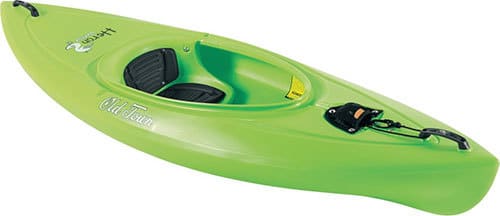
At 26 pounds it’s light enough for kids to tow by themselves.
It has an internal foam billet, providing additional flotation. If the kayak tips over, it won’t sink.
There’s also a tag along tow system. This rig will let you tow your child’s kayak along if they get too tired or have troubles.
The tow system can also be used as a chain if you have more than one child together for the ride.
The Heron Kids is for kids, but it doesn’t have an adjustable seat. You can’t adjust the seat as your child grows.
They can also be a bit difficult to enter without outside help. The billets may come apart after extended use.
Pros:
- Lightweight for both transport and towing
- Additional flotation
- Small size makes for easy paddling
Cons
- Some issues with flotation billets
- Non-adjustable seat
If your beginner kayak is a child, the Old Town Canoes and Kayaks Heron Kids model gives an easy to paddle kayak to learn on.
The in-built towing is excellent for helping kids keep pace or tag along when they get tired.
Wilderness Systems Tarpon 100 Sonar Kayak
For a starter sit-in kayak, the Wilderness Systems Tarpon doesn’t skimp out on the features.
With adjustable seating and great storage options with two compartments and additional deck lashing, it’s a comfortable experience suited for whatever excursion you may want to take.
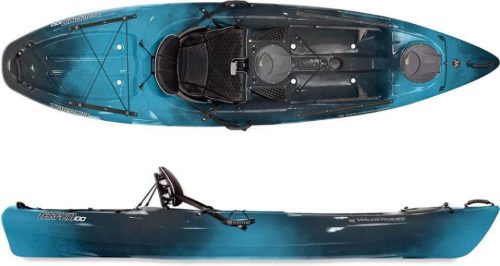
For those that want a little variety of color options, this kayak comes in five different colors, easily more than the others on our list.
The multi-chine hull works to give you secondary stability, both at high and low speeds.
Like some other kayaks on our list, this stability does come with the cost of being a bit harder to paddle and build up speed.
It also boasts a heavier weight, so moving it solo might be an issue. For a recreational vessel, it’s more suited to a fishing boat.
Pros:
- Color options
- Lots of storage space
- Great secondary stability
Cons:
- Heavy
- A bit harder to paddle
While considered a recreational vessel, the Wilderness Systems Tarpon will serve as a fishing boat for those wanting a cheaper option than the Pescador.
The multi-chine hull is a bonus for stability, and the color options don’t hurt its rating, either.
Best Beginner’s Kayak Editor’s Choice Review
Again, purchasing a beginner’s kayak is all about what you have in mind.
Most entry-level boats are recreational vessels, but that doesn’t mean you’re limited in your use.
Here’s a closer look at our top picks.
Editor’s Budget Choice – Sun Dolphin Aruba 10
For those just wanting to test out if kayaking is for them, I recommend the Sun Dolphin Aruba 10.
It may not get you too far on choppier waters, but it’s more than enough to get started with its easy steering and high primary and secondary stability.
While you can go cheaper with inflatable kayaks, the Sun Dolphin Aruba’s more durable material make it hold up for longer in rough conditions.
It’s also got better overall tracking than most inflatables, meaning you can focus on where you’re going more than struggling to keep up in a straight line.
The size and weight make for easy transport, too, so you shouldn’t have to go out of your way to incorporate this kayak into your next trip.
Editor’s Fishing Choice – Perception Pescador Pro 12
If wanting to fish is your primary reason for kayaking, the Perception Pescador Pro 12 takes my pick.
There are several higher-end fishing models on the market, but this one is comparable at a lower price point.
The larger weight may seem like a downfall, but I feel the stability and storage options more than balance for it.
The longer length than the Wilderness Systems Tarpon also makes for a more relaxed time paddling.
The salt-and fresh-water compatibility means you don’t have to limit your fishing locations.
Whether you’re looking for a trip down to the lake or some fishing at the ocean, this kayak will get you there and hold up to whatever water conditions you may encounter.
Editor’s Kid’s Choice – Lifetime Wave Youth
Giving a great start to a kid’s kayaking experience is valuable, and I feel the Lifetime Wave Youth does just what should be expected of a kid’s kayak and then some.
All the precautions are taken to keep the boat steady and free of water, and the smooth paddling should encourage enthusiasm from kids.
The swim-up step gives this kayak an extra edge, as it takes away the difficulty of boarding.
Keeping the kayak simple to get on means they can board without help, plus it serving as a safety feature is also a plus.
The UV resistant material scores it some points, too, as does the overall durability.
Considering it’s still lightweight enough for a kid to carry around on their own, only missing a few unessential features.
Editor’s Overall Choice – Ocean Malibu Two
The Ocean Malibu Two wins my vote for the best beginner kayak.
Not only is it suited for two paddlers, but a solo paddler can handle it with ease, and the high stability means you don’t have to worry about tipping overboard in any water conditions.
The durability wins points in this kayak’s favor, too, and not just for taking on any beginner’s mishaps.
This kayak will last you well past your practice stages and will even be suitable once you get some experience.
Even with the higher price point than other kayaks, you know you’ll be getting your money’s worth from this boat!
The Wrap-Up on the Best Beginner’s Kayaks
Most beginner kayaks are going to be recreational vessels, so if you want to get a little more serious with the sport, you will have to make a different purchase down the line.
However, for a starter vessel that you’ll still be trying to get a handle on the basics for, a recreational boat is more than enough to get your practice in on.
With the great variety of beginner’s kayaks out there, finding one that fits into your cost range while having the features you expect won’t be difficult.
top image credit: Deposit Photos
